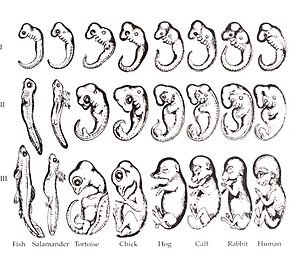Recapitulation theory facts for kids
The theory of recapitulation is an old idea about how living things develop before they are born. It's often summed up as "ontogeny recapitulates phylogeny." This means that the development of an individual organism (its ontogeny) was thought to repeat the evolutionary history of its species (its phylogeny).
This idea was first suggested by Étienne Serres in the 1820s. Later, in 1886, a scientist named Ernst Haeckel made it very popular. He believed that as an animal grows from a single cell into a baby, it goes through stages that look like the adult forms of its ancestors. For example, a developing human might look like a fish at one stage, then like a reptile, and so on.
While some parts of this idea have a bit of truth, scientists today don't see it as a complete or accurate way to understand development. It's not used much anymore in the way Haeckel described it.
Contents
Haeckel's Big Idea: Development Mirrors Evolution

Ernst Haeckel's main idea was "Ontogeny recapitulates phylogeny." Let's break down those big words:
- Ontogeny is the journey an individual organism takes as it develops. This starts from a single cell, like an egg, and continues until it's born or hatched.
- Phylogeny is the evolutionary journey of a whole species. This means how a group of animals or plants changed over millions of years from simple forms to what they are today.
"Recapitulates" means to repeat or reflect. So, Haeckel thought that an animal's development before birth was like a quick replay of its species' long evolutionary past.
For example, Haeckel noticed that developing humans have small slits in their necks for a short time. These slits look a bit like the gills that adult fishes use to breathe. Haeckel thought this meant that our very distant ancestors were once fish-like creatures. This part of his idea actually matches what we know from fossils and other evidence about evolution.
He also observed that unborn humans develop a tail for a while. Some babies are even born with a small tail. Haeckel believed this showed that our more recent ancestors, after the fish stage, had tails. Again, this idea is supported by what scientists know about human evolution.
However, not all of Haeckel's ideas or evidence were correct. He made several drawings of embryos that made them look more similar than they really were. These drawings ended up in many science textbooks, even though they weren't perfectly accurate. Also, Haeckel used his ideas to make harmful and racist claims, saying that some human races were more "evolved" than others. We know today that these views are completely wrong and unfair.
Why Scientists Changed Their Minds
Today, most scientists agree that Haeckel went too far with his theory. For example, the "gills" in a developing human don't actually work like fish gills. They are part of structures that develop into other things, like parts of the ear and throat.
Also, as scientists made better observations, they found that developing babies don't look exactly like the pictures Haeckel drew. It seems he might have made the similarities seem stronger to support his point. Haeckel also focused only on how bodies changed (their morphology). He didn't talk about how animal behavior evolved and developed.
But this doesn't mean the whole idea was useless. It's true that how we develop can give us clues about our evolutionary past. The connection just isn't as simple and direct as Haeckel thought. His very strong claims led to equally strong rejections later on.
Modern Views on Development and Evolution
Even though Haeckel's full theory isn't accepted, scientists today agree on some important points that are related to his ideas:
- When they are developing before birth, organisms from different species often look quite similar, especially in their early stages.
- This similarity tends to last longer for species that have split apart from each other more recently in evolutionary history.
- Developing organisms might have traits or features that they don't have when they are born. These features often look like traits that their adult ancestors had. This shows how evolution can reuse or change old developmental pathways.
Images for kids
-
Drawing by Wilhelm His of chick brain compared to folded rubber tube, 1874. Ag (Anlage) = Optic lobes, matching bulges in rubber tube.
See also
 In Spanish: Teoría de la recapitulación para niños
In Spanish: Teoría de la recapitulación para niños


